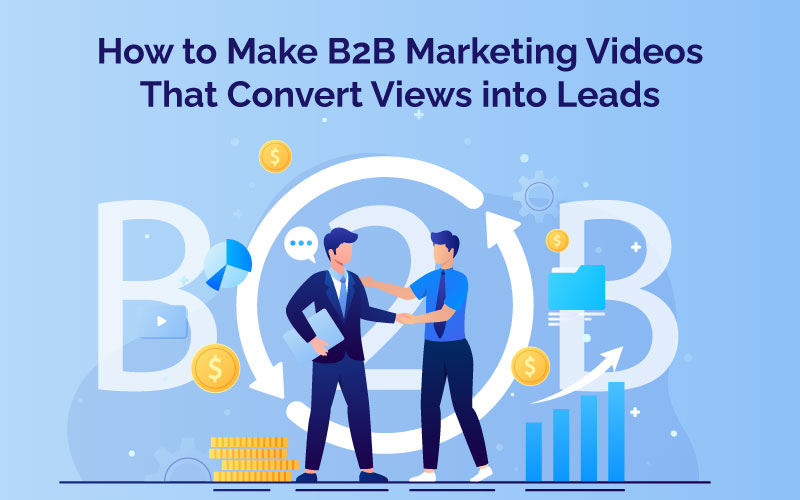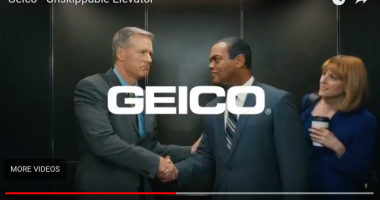
Table of Contents
- Why B2B Businesses Should Focus On Videos For
Marketing - What Makes A Marketing Video Great
- Top Types Of Marketing Videos (And How To Get Them
Right) - Conclusion
Why B2B Businesses Should Focus On Videos For Marketing
There was a time when it was easy to distinguish the practices that worked for B2B businesses and those that drove results for B2C businesses.
However, these days, that line is a little blurred, and for good reason. While some may consider that B2B purchase decisions are more “logical”, the truth is that they are still taken by individuals. Thus, the marketing you do needs to communicate with the right individuals or decision-makers.
In order to effectively communicate with them, you must capture their attention and video has emerged as one of the most engaging forms of content on the web. That’s perhaps why surveys reveal that:
- 81% of businesses use video marketing
- Nearly all surveyed businesses increased their marketing budgets in 2020
- Online users watch an average of 1.5 hours of video content every day
Let’s look at how marketing videos help B2B businesses:
Why B2B Businesses Should Focus On Videos For Marketing
A majority of B2B researchers these days are from the millennial generation and as mentioned earlier, they love watching videos.
A big misconception around using videos for B2B marketing is that prospects only watch videos when they are in the “awareness” stage of their buyer’s journey. However, surveys reveal that 70% of B2B decision-makers and researchers watch videos throughout their buyer’s journey.
The popularity of video, however, is not the only reason you should consider investing in video marketing for your B2B business. B2B marketing campaigns are enjoying more success than ever before.
The reason, besides the popularity of the video format, is data. With marketing videos, marketing teams now have access to granular consumer behavior data that wasn’t available before.
From tracking the watch time of videos down to the last second to tracking instances where consumers rewatch a video or a section of a video, marketers can reveal insights that can be used to improve engagement and conversion rates.
Videos in emails are known to improve open and click-through rates. In the case of search engines, video results are displayed on top of all the organic results.
All in all, the benefits of using video for B2B marketing are simply too significant to be overlooked.
With that said, producing result-focused marketing videos is no joke. In fact, producing a video that engages and inspires viewers to take action or interact with your business is the most pressing challenge associated with video marketing.
So how can you start producing marketing videos that delight your prospects? Let’s find out:
What Makes A Marketing Video Great
With 80% of businesses producing video marketing content, some videos are bound to perform better than others. Let’s look at the common elements present in the videos that perform well:
- Entertaining: Entertaining your audience is perhaps the easiest way to grab their attention. You may have heard the phrase that “good marketing does not feel like marketing”. This applies best to producing marketing videos for any business.
With entertaining videos, you can create a marketing experience that cares about more than just making sales. You can show your target audience that your brand is one that they can relate to, one that understands their struggles, pain points, and maybe even their humor.
- Educational: If you aren’t entertaining your audience, then you can add value in the form of education. This doesn’t mean your educational videos cannot be interesting or entertaining.
However, you must pay special attention to adding value. Make sure you are making videos educating viewers about the subjects that your audience cares about or struggles with. At the same time, don’t forget topics that are directly relevant to your products and/or services.
- Short: B2B marketing communication usually targets business decision-makers and individuals in decision-making positions in a business usually have a lot on their plate. They usually don’t have the time or the attention span needed to watch a 20-minute video, even if it isn’t a marketing video.
Most current video marketers understand that. Over 75% of B2B marketing videos produced in 2018 were less than 2 minutes long. It is safe to assume that this percentage has grown since. Keeping most of your videos shorter than the 2-minute mark is a good thumb rule, to begin with.
- Shared On The Correct Distribution Channels: This quality actually has dual meanings. One, the length and nature of your video need to be aligned with the platform where it is shared. A video developed for a landing page may not be suitable to be shared with your Instagram audience. Similarly, one meant for YouTube may not resonate with your audience on LinkedIn.
The other aspect of distribution is that the targeting of your videos will influence the choice of distribution channel. Meaning, if you are creating a video that talks about a case study of how one of your customers achieved success because of you, it may not perform that well on YouTube. Since that channel is mainly used to attract top-of-the-funnel prospects.
In this case, the correct channel to distribute the video may be your email marketing list, where consideration stage prospects are present. Alternatively, you can also use the video to retarget a certain type of website visitor with social media ads.
- Storytelling: An element of storytelling is extremely important if you want to create engaging videos. Humans love stories, they help them relate to the situations and instances being shown in a video.
Stories also help you bring more coherence to your ideas and connect your product or service with your prospects’ real-life struggles.
- Support Of Other Content Formats: If you are launching a video marketing campaign, make sure it doesn’t simply create one or even a single set of interconnected videos. While most of your prospects may prefer videos, not all of them do.
Moreover, it is also not necessary that all prospects that know about your brand and may find the video relevant will visit the platform where it is shared. That’s why it is important to use other content assets such as email blasts, social media posts, and website blog posts to make sure your marketing video gets the attention it deserves.
Another common and incredibly popular way to produce engaging videos is to repurpose other successful content pieces into videos. Since not all marketing videos are like this, this idea was not included in the above list.
Nonetheless, repurposing content works surprisingly well. This is primarily because the popularity of the content piece is already proven. By converting it into a video, you are making it more accessible to the part of your audience that doesn’t like reading content but won’t mind watching a video.
Now that we have understood the elements of a winning B2B marketing video, let’s look at the types of marketing videos that you can share with your audience.
Top Types Of Marketing Videos (And How To Get Them Right)
In this section, we will explore all the types of marketing videos that are relevant to a B2B business. We will also be discussing the elements that make those videos engaging and attractive and will also discuss examples that have achieved success for their creators.
Without further delay, let’s jump right into it:
Repurposed Video
We have already discussed this type of video and why it works. What you need to make your repurposed video work is:
- To understand what made the original piece of content and focus the video around that point.
- Add more value in terms of actionable information. Add something that was not mentioned in the original piece of content.
- Choose the right distribution channel. Just because a blog post on your website performed well, it doesn’t necessarily mean that the video will too. Think about the channels that drove traffic to the blog post and share the video on those channels.
- If you are sharing your repurposed video on multiple channels (which is strongly recommended), make sure you are editing the video to suit the content guidelines of that platform. For instance, if you are sharing a long-form video on YouTube and LinkedIn, and also want to share that content on Instagram, make sure you are also creating a short version fit for Instagram Reels or IGTV videos.
Example: HootSuite’s Holiday Mean Tweets
The trend of celebrities reading out mean tweets about themselves got a lot of traction back in 2017. Hootsuite saw this as an opportunity and decided to repurpose their user-generated content on Twitter in the form of a video. The clever part was, Hootsuite timed their ‘mean tweet’ video at the time of an update. The update addressed all the issues users pointed out with Hootsuite in their tweets.
To date, the video has garnered over 150,000 unique views on Facebook.

Live Video
Live videos are often used by social media influencers to interact with their audience and it has emerged as a surprisingly successful way to do that. However, live videos work a little differently in the case of B2B businesses. Since most B2B business followers are business decision-makers, a regular live video simply talking to your followers will feel like a waste of time.
That’s why live webinars have emerged as popular marketing tools. In fact, “webinar marketing” is now being viewed as a separate marketing discipline by a lot of marketing experts. Live webinars can be used to create hype around your products and services while delivering real value to your audiences. If you are thinking of hosting a live webinar, make sure you keep these tips in mind:
- Keep the agenda of the webinar extremely relevant to your business core competency and your audience’s pain points. In fact, I strongly recommend using your webinars to address the most pressing and common pain points faced by your audience.
- Unlike a regular live video, a B2B webinar needs to be approached as a planned event. This means it needs to be supported with other marketing activities to ensure attendance.
- Plan out the entire live event before it starts, down to the last minute. Sure, things may not go entirely as you have planned but having a plan will ensure you don’t go off-track at any point during the webinar.
- Make sure you are delivering actionable value. Your audience will take out time of their busy schedules to attend your online event. Make sure they don’t walk away feeling like they have wasted their time.
Alternative ideas for live videos are to live stream an industry event that you may be attending or host or stream a live video of a new product launch.
Replay Video
If you are hosting a live online event, there is a good chance that a significant percentage of your audience will not be able to attend it in real-time. That shouldn’t necessarily mean that they cannot watch the valuable content you meant to share with them.
To ensure this, make sure you are recording your own live stream every single time. After the event, all it would take is to edit the video a little bit and you will have a finished video, filled with valuable content, that you can share with your audience.
The best part is, you can even use the replay video as gated content. If your content is valuable enough, you can ask interested viewers to opt-in with their email addresses before viewing the video.
Example: Webinar Replay- Growing A Patreon Community
Hosted by Steve Dotto, who is the producer of one of Canada’s longest-running technology TV shows, the live webinar about growing a Patreon community had several value bombs. That’s perhaps why even the replay video has amassed over 34,000 views on YouTube.

Brand Video
From the perspective of a B2C customer, understanding the brand that they are purchasing from is not a high-priority matter. In most cases, B2C customers only care about the product and how well it does what it promises to do.
Things are, however, a little different in the case of B2B businesses. Most B2B businesses tend to look for long-term partnerships with their prospects, and for good reason. Besides establishing a predictable revenue stream, it gives them time to prove the effectiveness of their product or service.
However, establishing such a long-term partnership means customers will want to know about the brand they are partnering with. They would want to understand how things work at their (potential) partner organisation and how it is structured. This is where a good brand video becomes relevant.
There is no right or wrong way to create a brand video. The only guideline is, your brand video should be aligned with the brand personality that you want to forge.
Examples: I Like It When He Gives Me The Business:
This Zendesk video is perhaps the most popular example of a brand video. Unlike traditional and boring brand videos, this one uses humor to introduce the brand. The difference may not seem like a big one but it has helped the Zendesk video get over 150,000 views on YouTube.

On the contrary, Salesforce has created a lighthearted, semi-animated video introducing their popular brand. The video focuses on the capabilities of Salesforce and how it enables its customers. This video has over 250,000 views on YouTube.

Educational/Tutorial Video
Providing customers with value in the form of knowledge gained from your own experience is the backbone of content marketing, and it works beautifully well in the case of B2B videos.
To make sure your educational video content is as popular as the examples that follow, keep these tips in mind:
- Make sure you are choosing a topic that your audience cares about.
- Whatever subject you have promised to cover in your video, make sure you are covering it in its entirety.
- Make sure you are simplifying complex concepts for your audience. At the same time, keep their existing level of expertise in mind and don’t oversimplify.
- Keep your tutorials short. If a concept or subject requires a lengthy explanation, break it down into bite-sized videos. This practice is called microlearning and it has been psychologically proven to improve retention in learners.
Example: Moz Whiteboard Fridays
Moz Whiteboard Fridays is an SEO training series that was originally hosted by SEO superstar Rand Fishkin. The course is about a complex and vast subject but Rand breaks down his lessons into quick 6-7 minute videos focused on a single aspect of SEO. This particular video has over 54,000 views. For a weekly video series, that’s a superb number.

Product Video
Producing videos that promote products is an age-old aspect of marketing. Almost every television advert that you have ever seen is actually a product video.
However, all those “ads” or “product videos” are usually hardcore promotional. Meaning, they rely on making the product in focus attractive with the hopes of generating interest and ultimately, sales.
But business decisions are usually more logical. They are rarely influenced by how “cool” a product video seems. That’s why B2B businesses need to approach their product videos a little differently.
B2B businesses must use their videos to show how their product or service solves the pressing problems of their customers.
Example: SurveyMonkey
One of the best examples of such a product demo video is SurveyMonkey.
While the video is a little unconventional since it is over two minutes long, it does a great job of showing SurveyMonkey in action. The best thing about this video (in my opinion) is that it doesn’t miss out on mentioning any of the important features of SurveyMonkey.

Testimonial Video
Using social proof to support credibility and boost perceived dependability is a well-known marketing tactic. One of the most common ways to offer prospects social proof is in the form of testimonials. The reason testimonials are so popular among brands is simple- they are cheap, they get the job done, and they are easy to collect.
Surprisingly, video testimonials are more impactful than regular testimonials because they are not easy to collect.
Think about it, asking a customer to write a 50-word positive review is much easier than asking them to take out time to sit in front of a camera and answer questions about your brand or product.
However, this added challenge also goes to show that every customer that has appeared in a testimonial video is so delighted with your product or service (or both) that they are willing to go through the trouble of helping you create a testimonial video.
This is why testimonial videos inspire great confidence among prospects and work incredibly well at boosting conversions.
The best part is, your testimonial videos can be as professional as you want them to be. In fact, in many cases, testimonials recorded by customers using the front cameras of their phones look much more authentic than professionally created videos.
With that said, professionally created video testimonials have their own advantages. Besides offering excellent cinematography, professionally done video testimonials allow for strategic scripting of the video.
Example: On-Demand Advisors
Using a script is a great way to ensure that your video testimonial is focused on the important aspects of your product or service. The following is a great example of the same:

This testimonial is great not just because it is beautifully made, but also because it goes into specific details about how ICUC was able to benefit from the services offered by On Demand Advisors. The video gives specific numbers that show the improvement brought about by On Demand Advisors (“we went from 15 leads a month to 300 leads a month”).
Video Case Study
Case studies are high-impact content, even when they are not presented in the form of a video. However, the video format can seriously boost the marketing potential of showing off how you have made the lives of your existing clients a delight.
Example: SalesForce
One of the best case study videos I have personally watched is by SalesForce. The one thing that I especially love about this video is that it hardly ever mentions Salesforce. The entire video is about Barclays, a client of Salesforce, and how they are using CRM to do better business.

Salesforce’s approach for this video resulted in the video going viral. As you can see, it has amassed over 48,000 views.
Explainer Video
Explainer videos do exactly what the name suggests, they explain what your business does. Such videos may seem very similar to product demos but actually follow quite a different approach.
While product demos are about your products and their features, most explainer videos are about the benefits of your product or service and the advantages that your customers enjoy as a result of those benefits.
Explainer videos are especially relevant in the case of B2B businesses that are solving complex problems.
Example: Frrole
Social media marketing has become a necessity for businesses that are looking for online success. Social media intelligence is one of the most important but least-known sources of data that businesses can use to their advantage.
Frrole tells businesses about their audience in innovative ways. While the concept is a little difficult to put into words, this video does an excellent job of explaining what Frrole does:

Expert Interviews
Expert interviews are an excellent way to educate your audience, establish your brand as an industry authority, and educate your audience.
B2B brands can interview subject matter experts and industry leaders in their own companies or conduct interviews with influential personalities in their industry.
There are a few things that make expert interviews great and attractive to audiences. While the choice of the expert that you are interviewing has an obvious influence over the popularity of your video, others like keeping the tone conversational and using open-ended questions.
Controversy also works well in the favor of expert interviews. There are two ways you can introduce the element of controversy to your expert interviews. You can either ask controversial questions or you can choose to interview a popular personality whose views don’t align with your own (or your brands’).
Conclusion
There you have it, the process and the elements that you need to create a winning B2B video. Choose the type of video you are making based on the availability of resources, expertise, and of course, your budget. I hope that the examples shared in this article will give you the right inspiration to create your own conversion-focused B2B videos.





